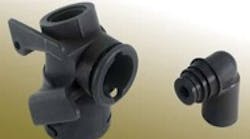Developed for use on Air Force tactical aircraft such as the F-4 Phantom and the F-15 Eagle, the CRU-60/P is a critical 2-piece connector that joins the aircraft's oxygen supply to the pilot's mask.
Shown here with black anodized finish, the connector assembly features an emergency bailout elbow that connects with an oxygen bottle in the seat, so the pilot is able to breathe when ejected from the aircraft.
A world leader in the development and fabrication of integrated life safety products, Alloy Die Casting, Buena Park, CA, is precision diecaster that recently had a hand in developing a critical safety component for a U.S. Air Force tactical aircraft, and helped to solve porosity issues and reduce scrap rates for the component production process.
The component is the CRU-60/P, two-piece connector that joins the aircraft's oxygen supply to the pilot's oxygen mask. It was developed for use on U.S. Air Force tactical aircraft equipped with ejection seats, such as the F-4 Phantom and the F-15 Eagle.
Gentex Respiratory Products, Rancho Cucamonga, CA, designs, develops, and manufactures aviation oxygen masks and positive-pressure breathing systems that help fighter pilots maintain consciousness during high-G maneuvers. The company's CRU-60/P Connector mates the pilot's mask to the oxygen supply, but it also has an emergency bailout elbow that connects with an oxygen bottle in the seat, so the pilot is able to breathe when ejected from the aircraft. For this critical application, the finished parts have tolerances as tight as 0.003 in., and they are subjected to a battery of performance tests before being certified as field-ready.
"The CRU-60/P connector assembly undergoes a number of stringent performance tests before it's sent into the field," explains Gentex Respiratory Products manufacturing manager Bill Kirk. "If the diecast part is too porous, especially in critical areas like the O-ring groove, it won't meet the leakage requirements. In today's high-G, high altitude aircraft, excess porosity could deprive a pilot of essential oxygen in a combat or emergency situation."
Gentex located and contracted Alloy Die Casting to manufacture the connector, and it set a target scrap rate below 4% rejects after all testing is completed.
Alloy Die Casting manufactures large, small, and complex diecastings in aluminum and zinc/aluminum alloys for more than 50 years. Customer-furnished or jointly-developed designs are produced, always in accordance with military, aerospace, medical, automotive and industrial requirements. ADC is registered to the ISO-9002 and AS-9100 standards, as well as to various industrial and military specifications, including MIL-I-45208. It produces diecastings up to 300 in.2 surface area, and offers decorative and/or protective coatings. It can even bond elastomer components, e.g., seals and/or gaskets, to castings, to produce subassemblies.
"Many diecasting facilities today focus on high-volume production," says ADC design engineer Gary Gray. "We've become very adept at designing diecast tools and processes for intricate, close-tolerance parts that other shops might shy away from in low to medium volumes."
The Gentex CRU-60/P is the industry standard for restraint harness connectors, so it meets all the requirements of the USAF specification MIL-C-38271B. Typically secured to a dovetail mounting plate attached to an airman's parachute harness, the design delivers positive locking and prevents flailing during an ejection. When installed in position, the CRU-0/P connects to a conventional three-pin bayonet oxygen mask hose connector. The aircraft supply end incorporates an omni-directional, quick disconnect to ensure proper alignment at all times, an advanced fitting design that also warns the pilot when a disconnection has occurred.
To hold down the part cost, Gray elected to design a family die to cast both components of the connector, because they must be assembled together to create a complete unit. "This two-cavity die is a custom-built tool," he said. "Because of the angles involved on the components, standard tool holders would not work here. So we built a dedicated tool, with a total of five slides.
"We took great pains to design in excellent venting and precise temperature control," explained Gray. "Because of the porosity restrictions, we really wanted to avoid trapped gas in the casting, so the gates and runners were sized and located with that objective in mind."
During trial runs, ADC engineers took the first castings into the company's extensive testing facility, where they used realtime X-rays to evaluate the porosity. "Secondary operations like milling and grinding have a tendency to make porosity issues more apparent," Gray added. "The X-ray inspection helps us spot potential problems with trapped gases, so we can adjust the shot speed and other parameters to force trapped air to the overflow."
The Gentex CRU-60/P connector is cast from A380 aluminum on a 250-ton Toshiba press, which features automated ladling and extraction, as well as air jets to cool the parts as the conveyor takes them to the trim press. Aluminum ingots are melted in a reverberatory furnace at approximately 1,200°F, and a measured shot is injected at about 8,000 lb/in2, producing a gate velocity around 1,200 in/sec.









